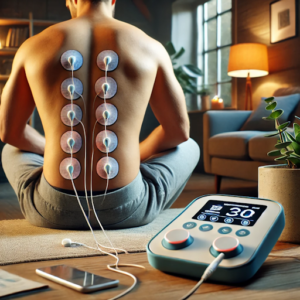Effectively Managing Back Pain Through Electrotherapy
Back pain is a widespread issue affecting millions worldwide, transcending age, gender, and lifestyle factors. It can manifest in various ways, from sharp discomfort lasting a few days to chronic pain that persists for months or years. Often, back pain stems from a combination of physical, psychological, and environmental factors.
Common causes of back pain include muscle strain, herniated discs, arthritis, and poor posture. The variability in how back pain is experienced complicates diagnosis and treatment. While some may find the pain tolerable, others could be severely debilitated, requiring a comprehensive approach from healthcare professionals.
Beyond physical health, chronic back pain can take a toll on emotional well-being, often leading to anxiety, depression, and social isolation. The economic implications are substantial, as back pain is one of the leading causes of disability and reduced productivity in workplaces.
Understanding the underlying causes of back pain is crucial for developing effective treatment strategies. One such strategy is electrotherapy, which has gained recognition for its ability to relieve pain and promote recovery.
Summary
- Back pain may result from factors like poor posture, muscle strain, or injury and significantly impact daily life.
- Electrotherapy is a non-invasive technique that uses electrical energy to manage pain and promote healing.
- Electrotherapy offers pain relief, muscle relaxation, improved circulation, and reduced inflammation.
- Different electrotherapy methods like TENS and EMS can help alleviate back pain.
- When using electrotherapy, it’s important to follow healthcare professional advice and avoid using it near the heart or on broken skin.
 Introduction to Electrotherapy
Introduction to Electrotherapy
Electrotherapy refers to various techniques that use electrical energy to treat conditions like back pain. This therapeutic approach has evolved, utilizing advanced technologies to offer pain relief and promote healing. Electrotherapy can target specific areas of discomfort by stimulating nerves and muscles through electrical impulses.
Unlike medications, which may cause side effects or dependency, electrotherapy is non-invasive and effective in managing back pain. As research continues, the benefits of electrotherapy are becoming more widely recognized, leading to its integration into comprehensive pain management plans.
Benefits of Electrotherapy for Back Pain
One of the primary benefits of electrotherapy is its ability to provide immediate pain relief. Elect electrotherapy interrupts pain signals by sending electrical impulses to the affected area, reducing discomfort.
Additionally, it promotes the release of endorphins, the body’s natural pain relievers, further enhancing its effectiveness. Electrotherapy also improves blood circulation and reduces inflammation, supporting the healing process. This combination of immediate and long-term benefits makes electrotherapy a valuable tool for managing back pain.
Types of Electrotherapy for Back Pain
Electrotherapy encompasses various methods, each targeting different aspects of back pain management. TENS (Transcutaneous Electrical Nerve Stimulation) is a popular technique that delivers low-voltage electrical currents to relieve pain. Its portability and ease of use make it ideal for home treatment.
IFC (Interferential Current Therapy) uses medium-frequency electrical currents to reach deeper tissues and address musculoskeletal issues. Additionally, EMS (Electrical Muscle Stimulation) and microcurrent therapy are increasingly recognized for stimulating muscle contractions and aiding tissue repair.
 How to Use Electrotherapy for Back Pain Management
How to Use Electrotherapy for Back Pain Management
Following specific guidelines is crucial to ensuring safety and effectiveness when using electrotherapy. Patients should consult a healthcare provider to determine the best electrotherapy option. Once a treatment plan is in place, therapy can be administered in a clinical setting or with portable devices at home.
Home users must follow the manufacturer’s instructions for electrode placement, intensity, and session duration. A typical session lasts between 20 and 60 minutes. Consistency is key, as regular treatments offer cumulative benefits over time. Regular communication with a healthcare provider is essential to track progress and make adjustments if needed.
Precautions and Considerations When Using Electrotherapy
Although electrotherapy is generally safe, certain precautions should be taken to avoid complications. Individuals with heart disease, epilepsy, or implanted devices like pacemakers should consult a healthcare provider before using electrotherapy. Pregnant women are also advised to avoid electrotherapy near the abdomen or lower back.
It is important to avoid placing electrodes on open wounds or infected areas. Patients should also monitor their bodies for adverse reactions during treatment and stop immediately if they experience increased pain or skin irritation.
 Integrating Electrotherapy with Other Back Pain Management Techniques
Integrating Electrotherapy with Other Back Pain Management Techniques
Integrating electrotherapy with other treatments can enhance back pain management. A holistic approach often yields better results than relying on a single therapy. Combining electrotherapy with physical therapy can strengthen muscles and improve flexibility while addressing underlying musculoskeletal problems.
Making ergonomic adjustments at work or home can further enhance the benefits of electrotherapy by reducing strain on the back. Additionally, incorporating stress-reducing practices like yoga or meditation can help alleviate pain perception by promoting relaxation.
FAQs
Can you tell me about electrotherapy for back pain?
Electrotherapy uses electrical stimulation to manage and relieve back pain—standard methods in inStandardTENS and EMS.
How might electrotherapy help with my back pain?
Electrotherapy stimulates nerves and muscles to improve blood flow, promote healing, block pain signals, and trigger the production of endorphins, the body’s natural painkillers.
Is it safe to use electrotherapy for back pain?
Electrotherapy is generally safe when guided by a trained healthcare provider. Follow recommended protocols and avoid applying the device near the head or heart.
How does electrotherapy work for back pain?
Electrotherapy relieves pain, reduces muscle spasms, and improves flexibility. It’s a non-invasive and drug-free option for managing back pain.
Who can benefit from electrotherapy for back pain?
Electrotherapy may benefit individuals with conditions such as strained muscles, arthritis, sciatica, or herniated discs as part of a broader pain management strategy.
Are there any situations where electrotherapy isn’t recommended?
Electrotherapy is not recommended for individuals with pacemakers, epilepsy, or heart conditions. Consult a doctor before starting treatment.
Brought To You By: Back Pain Therapy
The Article: Managing Back Pain with Electrotherapy appeared first on https://mcrtherapies.co.uk
The Article Managing Back Pain with Electrotherapy appeared first on https://mcrtherapies.com
The Article Managing Back Pain with Electrotherapy Was Found On https://limitsofstrategy.com


It’s interesting to see the multifaceted nature of back pain highlighted here, especially the interplay between physical and psychological factors. I’ve personally experienced how a seemingly simple muscle strain can escalate into a chronic issue, triggering not just physical discomfort but also emotional distress. The mention of poor posture resonated with me; it’s surprising how often we overlook our daily habits—sitting for long hours, particularly while working from home, can exacerbate these conditions.
It’s great to hear your perspective on this. I think a lot of us can relate to that experience where a simple muscle strain spirals into something more complicated. It’s wild how quickly our bodies can go from minor annoyance to chronic pain, and that emotional toll can often feel just as heavy as the physical one.
Your exploration of back pain and its multifaceted impact resonates deeply with me, particularly as I’ve navigated my own challenges with chronic discomfort over the years. Like many, I’ve experienced the frustrations that come with persistent pain, and it truly does intersect with so many areas of life, influencing both emotional and psychological well-being.
I really appreciate you sharing your experience. Navigating chronic pain can be incredibly isolating, and it’s interesting how it seeps into every aspect of life, isn’t it? Sometimes, it feels like the physical discomfort leads to emotional burdens that make everyday activities feel monumental. I’ve had my own struggles with pain, and I found that it often feels like a dance between accepting the reality of the condition and pushing against it to reclaim some semblance of normalcy.
It’s striking how chronic pain weaves itself into the fabric of daily life, isn’t it? Your reflections highlight an essential reality that often gets overlooked: the way persistent pain impacts not just our physical bodies but also our emotional and mental landscapes. Many people underestimate the toll that chronic discomfort can take on relationships, work, and even the simplest joys of life. When pain becomes a constant companion, it can feel like a thief, robbing us of moments that once brought happiness.
Your insights on the complexities of back pain resonate deeply with many of us who have encountered the debilitating effects of this condition. I can personally relate to the emotional toll chronic pain can take; it’s not just about physical discomfort. It often creeps into our mental space, leading to feelings of anxiety and isolation.
I can really appreciate where you’re coming from. The emotional toll of chronic pain is often overlooked, yet it can be just as debilitating as the physical symptoms. It’s like an invisible weight that you carry around, affecting everything from your mood to your daily activities. I’ve seen friends go through similar struggles, and it’s heartbreaking to witness how isolation can creep in when you’re dealing with something that’s hard to explain to others.
I completely resonate with what you’ve shared. It’s so true that the emotional toll of chronic pain is often sidelined in conversations about health. It’s like this constant background noise that most people can’t hear, but it influences everything you do. I found myself in similar situations where even explaining my experience felt futile—most people struggle to understand something they can’t see.
It’s interesting how that constant background noise of chronic pain can shape our daily lives in ways that others might not even realize. I’ve felt that disconnect too—trying to articulate something so personal and complex to someone who simply hasn’t experienced it can leave you feeling a bit isolated. It’s almost like you’re speaking a different language.
I completely relate to what you’ve shared, and I found this piece on managing sciatica pain really insightful; it dives into some effective therapies that might resonate with those of us navigating the often unseen emotional challenges alongside chronic pain.
‘Sciatica Relief: Best Therapies for Pain Management’
https://mkpitstop.co.uk/sciatica-relief-best-therapies-for-pain-management/.
I completely understand where you’re coming from. Back pain really does have a way of affecting so much more than just our physical state; it seeps into our daily lives and mental well-being. I’ve noticed how easily it can shift our focus from active engagement in life to a sense of withdrawal, which can amplify feelings of anxiety and isolation.
The discussion around managing back pain through electrotherapy resonates with many experiences I’ve encountered. I’ve found that integrating technology, such as TENS units, not only helps alleviate pain but also empowers patients to take a more active role in their treatment. This personalized approach can be vital, especially for those who, like you mentioned, struggle with the emotional toll of chronic pain.
I really appreciate your insights on the role of technology in managing back pain. The way you describe your experience with TENS units highlights a crucial element of chronic pain management: the importance of patient empowerment. When individuals feel like they have tools at their fingertips—like electrotherapy devices—it can shift the dynamic from passive suffering to active engagement in one’s own healing process.
Your exploration of back pain resonates deeply with so many of us navigating its challenges. I can relate to the emotional impacts you mentioned; I faced chronic back pain myself due to a past injury. At times, it felt like a heavy cloud hanging over both my physical and mental well-being.
I really appreciate you sharing your experiences with chronic back pain. It’s so true how that heavy cloud can seem to linger over every aspect of life, both physically and emotionally. I’ve been there too, and I think what often gets overlooked is how intertwined our physical and mental states really are.
I really resonate with what you’re saying about that heavy cloud. It’s interesting how chronic pain can seep into every corner of life, affecting not just our bodies but our mental space, too. There’s definitely a stigma around discussing the emotional toll of physical ailments, as if we should just keep pushing through.
You hit the nail on the head with that heavy cloud analogy. Chronic pain isn’t just a daily struggle with discomfort; it’s more like having a moody roommate who decided to move in without warning. They hog the remote, complain about the music you play, and just generally dampen the vibe. It sneaks into everything—your plans, your mood, even your late-night snacks (seriously, the ice cream never stands a chance).
It’s interesting how back pain can feel like a weight that affects not just our bodies but our minds too. I completely understand that feeling of a heavy cloud—you find yourself constantly shifting your focus to manage the pain instead of enjoying those more spontaneous moments in life.
I completely understand where you’re coming from; I recently came across some effective treatment options for sciatica that really opened my eyes to managing the emotional and physical burdens of back pain.
‘Sciatica Relief: Explore Effective Treatment Options’
https://mkpitstop.co.uk/sciatica-relief-explore-effective-treatment-options/.
I found your insights on managing back pain through electrotherapy particularly compelling. It’s interesting how multifaceted back pain can be, affecting not just physical health but also mental and emotional well-being. I can relate to this; I’ve struggled with lower back pain after long hours of sitting at a desk, and it became a cycle that impacted my mood and motivation.
Your exploration of back pain and its multifaceted impacts really resonates with me, particularly the emphasis on its psychological toll alongside the physical aspects. I’ve experienced back pain myself, stemming from a mix of poor posture and stress, and have seen firsthand how it can spiral beyond just physical discomfort; I often found myself facing heightened anxiety and a sense of isolation when the pain flared up.
I can really relate to what you shared about the psychological impact of back pain. It’s so interesting how intertwined the body and mind are; I’ve noticed similar patterns in my own experience. Stress really does have this ability to manifest physically in ways we wouldn’t expect.
I hear you—it’s wild how back pain can have that ripple effect on our mental space. It’s not just about discomfort; it can really mess with your mood and how you connect with others. Poor posture and constant stress seem to create this perfect storm, don’t they?
It’s evident that back pain affects so many aspects of life, making effective management crucial. I’ve experienced how debilitating lower back pain can be; it’s not just about physical discomfort, but also the way it can seep into one’s emotional well-being and day-to-day activities.
You really hit the nail on the head. Lower back pain can creep into every corner of life, can’t it? It’s not just about the physical part; it can mess with your mood and even how you relate to others. I’ve heard stories of people feeling isolated because they can’t join in on activities they once loved.